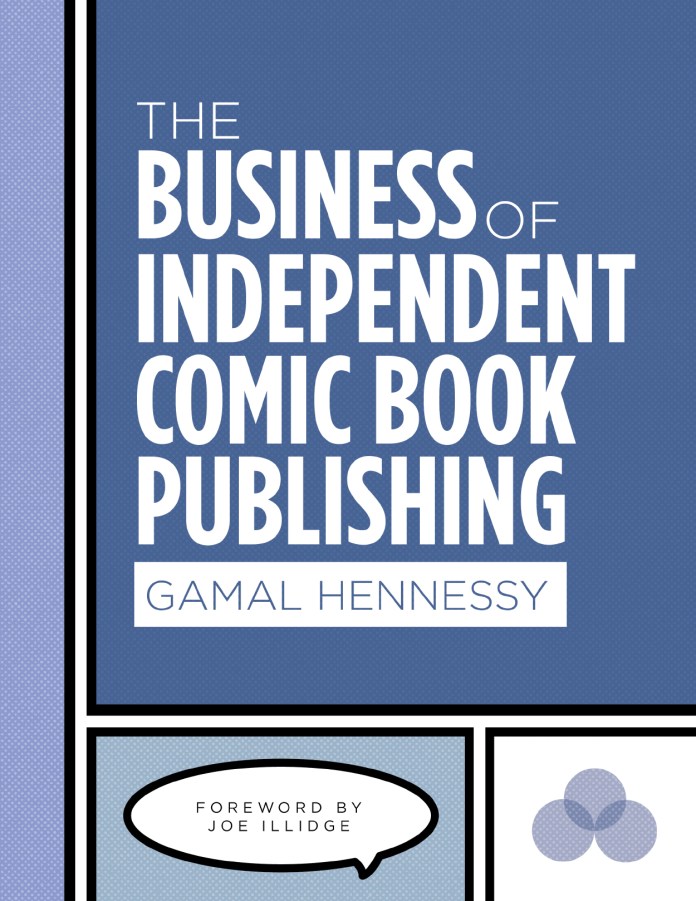A new book by an entertainment attorney offers guidance for the business of indie comics, with involvement from a pair of big names in the business — Heavy Metal executive editor Joseph Illidge and AfterShock Comics editor-in-chief Mike Marts.
The book — dubbed The Business of Independent Comic Book Publishing — was written by Gamal Hennessy. Illidge penned the forward while Marts served as editor on the project. It launched on Kickstarter today, and to promote it, Hennessy was kind enough to do a quick interview with The Beat. Hennessy (as we discuss here) is an experienced entertainment attorney, and the book seeks to answer questions such as how much money does one need to publish an indie comic, does social media outreach matter, and more.
Check out our full interview about the book and the business of indie comics with Hennessy below! And you can also visit the campaign page now.
ZACK QUAINTANCE: Comic book attorney is an excellent title, can I start by asking what drew you to practice law as it relates to the comic book industry?
GAMAL HENNESSY: I stumbled into comic book law with no idea about what I was doing. When I was in law school (which was about 300 years ago), my goal was to work in entertainment law. I read comics long before law school and that didn’t stop when I was trying to get my degree. After I passed the bar, I didn’t have a job, but a fellow classmate told me about a job she turned down at a manga company called Central Park Media. Becoming general counsel there was my first job in the industry and comic book law has been most of my focus ever since.
QUAINTANCE: I know you have two decades of experience as an entertainment contracts attorney, but can you tell me — someone whose understanding of that job comes mostly from movies — what sort of work that entails?
HENNESSY: Comic book law is a specialization within publishing law, which itself is a specific combination of entertainment law and intellectual property law. The two major areas of focus are the intellectual property contained in comics (copyrights and trademarks) and the contracts that define relationships in the comic book business (work for hire contracts, creator-owned contracts, licensing agreements, distribution agreements, etc.).
The biggest difference between general publishing law and comic book law is the financial value of the characters off the printed page. Hamlet and Captain Ahab might be well known literary characters, but Batman and Spider-Man generate a lot more money in merchandise and licensing. So most comic book publishing contracts mention something about film and TV rights, even if most comics don’t reach that level.
QUAINTANCE: The new book sounds absolutely essential for comics creators. How did you decide what advice to put in?
HENNESSY: I wanted to walk the reader through the entire process of publishing independent comics. My legal work helped them answer some questions. There are also several great books on the market that focus on the creative aspects of comics. But there wasn’t a single source for aspiring creators to find out about the full process from initial inspiration to a flourishing publishing program.
I wrote The Business of Independent Comic Book Publishing to provide that information. It walks you through each of the twelve major stages of comic book publishing, describes the decisions that need to be made in each stage, lists the major options available for each decision, discusses the pros and cons of each decision and how it relates to the overall process. At the end of the book, each reader can develop an individualized business plan that is specific to the story they want to tell and their personal and professional circumstances.

QUAINTANCE: What about our current times makes it so important for comic creators to be well-versed in the law as it applies to them and their work?
HENNESSY: The law and its impact on the business of comics have always been crucial for creators and publishers. You learn the same lesson whether you look at the Siegel and Shuster battle over Superman or the McFarlane and Gaiman battle over Angela or the Walking Dead lawsuit or the thousands of other unknown creators who lost or signed away their rights over the years. Comic book creators who don’t understand or protect the rights to their characters and stories risk losing everything they worked so hard to make. But if they understand the business of comic book publishing, they can create viable businesses of their own instead of always making money for someone else.
QUAINTANCE: Finally, is there one thing from your perspective that the vast majority of new comics creators do wrong, and if so what is it?
HENNESSY: I see three major mistakes on a frequent basis.
First, an inspired creator decides to publish a comic without a solid legal or financial plan to get their book out into the world. This often leads to wasted money and a precarious legal status for the intellectual property of the book, if the book ever comes out at all.
Second, they don’t try to find readers for the book until the book is in Previews or the files have been sent to the printer. This leads to a publisher who has a book but no real audience to read it.
Finally, new comic book publishers often strive to attract existing direct market comic book readers instead of trying to use the appeal of their story to connect with new readers who aren’t familiar with the magic of comics yet. This leads to a frantic situation where everyone is fighting for the same readers in a stagnant or shrinking market.
The comic book creator who understands the business of independent comic book publishing can avoid all these problems and give their book a better chance of success. Independent success stories are possible. The Umbrella Academy is a great example of that. The key is to support the creative vision with the business foundation.
Source: https://www.comicsbeat.com/interview-new-book-tackles-the-business-of-indie-comics/





